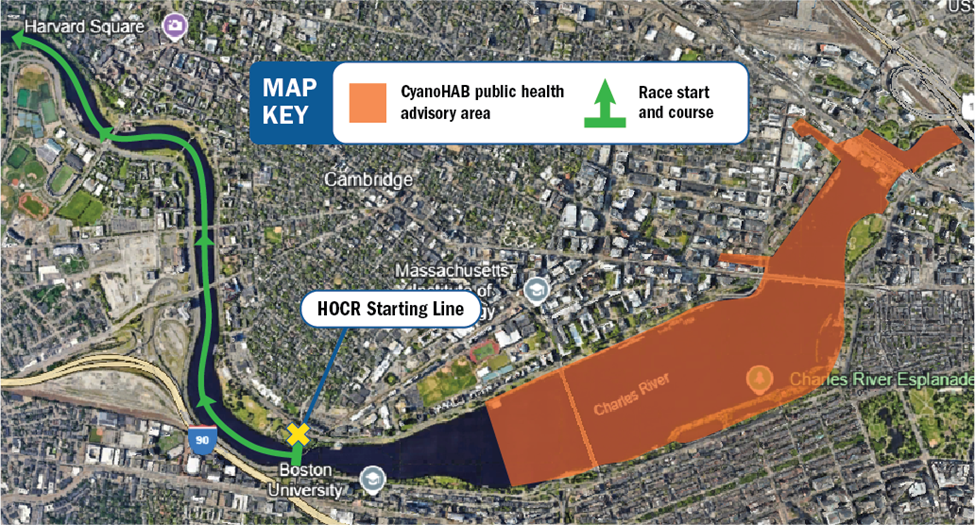October 17, 2025
Update on Cyanobacteria Algae in the Charles River: Health Advisory Lifted in Two Areas, but Remains in Two Other Locations

The Cambridge Public Health Department is updating residents of the updated status of the cyanobacteria algae bloom in the Charles River. The cyanobacteria algae bloom advisory area, which was first issued in July and then that area expanded in early October, has been reduced.
The new alert issued by the Department of Public Health (MDPH) has lifted the water areas around Magazine Beach and the Boston University DeWolfe Boathouse. No parts of the upcoming rowing competition Head of the Charles Regatta course remain under the advisory area. See map above for details. However, the alert in the areas downstream of the MIT Richard J. Resch Boathouse and the Community Boating currently remain in place as more sampling needs to be done to make sure the algae are not at levels that exceed the state’s toxin guideline levels. Residents and their pets are urged to avoid contact with the water and any areas where there is visible algae as it can make them sick. Animals, especially, can get very sick from contact with or even die within hours of coming into contact with harmful algae or cyanobacteria.
Background
On October 14, 2025, MDPH collected follow-up samples at four locations in the Charles River. At all locations, laboratory analysis showed cyanobacteria concentration below MDPH’s toxin guideline levels, meaning the algae are no longer at levels that are considered unsafe.
MDPH requires two rounds of sampling, one week a part, with values below the guideline levels to recommend rescinding an advisory.
Locations tested:
- For Magazine Beach and the BU DeWolfe Boathouse, this is the second round of low results, therefore, the advisory is lifted for these areas.
- For the MIT Richard J. Resch Boathouse and Community Boating, this is the first round of low results, therefore the advisory will remain in place for areas downstream of these locations. MDPH will sample these locations again next week to see if the whole advisory may be lifted.
The intent of this updated advisory is to ensure the public is aware of the potential health risk and to provide individuals with the information needed to make an informed decision about whether to recreate at the Charles River. This includes swimming, fishing, boating, jet skiing, rowing, or engaging in other recreational activities on/in the water.
While this health advisory is still in effect for part of the Charles River, individuals should not:
- Consume fish from this area
- Allow dogs to swim in or drink the water
What is algae or cyanobacteria? Why is it dangerous?
Algae and cyanobacteria (also called blue-green algae) are plant-like organisms that live in water. They can quickly grow out of control, or “bloom.” When these blooms form yellow-green mats, they may produce neurotoxins (primarily microcystin) that make people and animals sick if ingested.
If you, your child, or your pet comes in contact with the water, rinse off immediately. Contact can cause skin and eye irritation, and inhalation or ingestion can cause respiratory irritation and other illness. If the blue-green algae are producing toxins, the health effects can be serious. More information about illnesses caused by harmful algal blooms can be found on the CDC website.
Contact a veterinarian immediately if your pet seems sick after going in or near water. Animals can get very sick or even die within hours of coming into contact with harmful algae or cyanobacteria.
As noted above, MDPH will continue to monitor cyanobacteria algae levels in this area. More information about harmful algal blooms can be found on the MDPH’s website.
